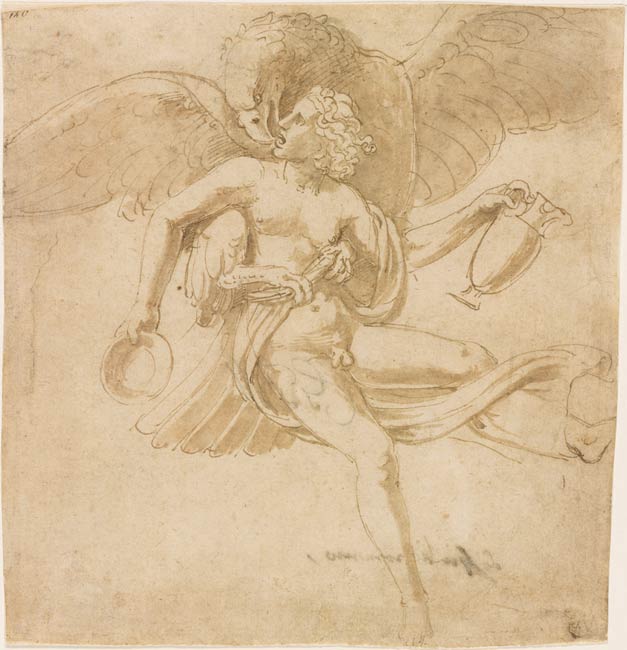
Vasari noted that after the death of Raphael, Giulio Romano was considered the best designer working in Italy.1 Accordingly, when in the early 1520s Federico Gonzaga, the Marquis (and later Duke) of Mantua, commanded Baldassare Castiglione, his ambassador in Rome, to procure the best available artist to oversee the renovation of the Palazzo Ducale and other works in Man- tua, Giulio was the natural choice.2 In the autumn of 1524, with Giulio’s work on the Sala di Costantino of the Vatican Palace complete, the artist was persuaded to move to Mantua. The range of work he undertook once there is astonishing. Having overseen the refurbishment of the Palazzo Ducale, he moved on to design and decorate the Palazzo Te. Giulio was also responsible for everything from a new urban plan to court entertainments to tableware (see 1972.18). He was, in sum, the impresario for all artistic and architectural endeavors at the Gonzaga court, and a vast body of drawings related to his diverse inventions survives.
Giulio’s decorative programs for the Ducal Palace and Palazzo Te were built around an elaborate iconography based on the Gonzaga coat of arms and various emblems and imprese associated with Federico and his family. The principal motifs of the Gonzaga arms are eagles, derived from the arms of the Holy Roman Emperor and bestowed upon the Gonzaga by Emperor Sigismund in 1443.3 It is typical both of Giulio’s fertile imagination and of the erudite Mannerist culture of the mid-sixteenth century that the eagle opened a string of associations: it was, for example, associated with Jupiter, and thus Jupiter and his extended mythology came to be linked to Federico as well. Lightning bolts also feature prominently in Giulio’s designs, and Jupiter’s sexual exploits likewise appear frequently in the palace decorations.4
The principal source used for the Loves of Jupiter was Ovid’s Metamorphoses, in which a notable aspect of the tales was the god’s transformations into a swan (the story of Leda), bull (Europa), satyr (Antiope), or eagle (Ganymede). This last metamorphosis is shown here in an unashamedly sexual depiction with the god embracing the youth Ganymede from behind as the boy and bird prepare for an open-mouthed kiss. The myth of Ganymede was frequently represented during the Renaissance,5 and Giulio seems to have based his rendering on an ancient sculpture that he would have known in Rome.6 The subject was rarely depicted with the frank eroticism seen here, although, as often noted, Giulio’s version is typical of the permissive mores of the Mantuan court and its hedonistic duke.7
Giulio devised the Ganymede composition for one of the stucco roundels on the ceiling of the Camera delle Aquile (Room of the Eagles) in the Palazzo Te.8 Although these stucchi on the vault would seem to be relatively minor parts of a decorative scheme, a series of surviving drawings by Giulio himself relates to the many parts of the ceiling.9 The room was the ducal bedchamber, and Giulio must thus have attached special importance to its decoration. Several years later, the Ganymede composition was reused for a stucco relief at the center of the ceiling of the Camerino dei Falconi at the Palazzo Ducale, a small public room whose decoration was probably carried out mainly by Giulio’s assistants.10
—JJM
Footnotes:
- Vasari uses the word artefice, suggesting not merely “artist” but something more like today’s “designer,” someone whose talents extended to architecture and other design work as well as painting.
- Vasari 1878–85, 5:535.
- See, for example, Giulio’s playful design for a decorative panel or tapestry with the arms of Cardinal Ippolito Gonzaga: The Morgan Library & Museum, New York, inv. IV, 16. See New York 1999, no. 14.
- In addition to the designs by Giulio discussed here, Correggio’s five paintings of the Loves of Jupiter, commissioned by Federico beginning in 1527, are another prominent example.
- Saslow 1986, 63–141.
- The sculpture, now in the Museo Archaeologico in Venice, was until 1523 in the collection of Cardinal Domenico Grimani in Rome. See New York 1999, 90.
- See New York 1999, 90–91.
- Belluzzi 1998, 1: under no. 676, first recognized this connection.
- New York 1999, nos. 20–24.
- Hartt 1958, 1:170, linked the drawing to this project, not recognizing its original use in Palazzo Te.
Watermark: none.
Inscribed in upper left corner, in pen and brown ink, "140"; on verso at center, in pen and brown ink, "GFM"; at lower left, in pen and brown ink, "di giulio romano".
Walraven, Izaak, 1686-1765, former owner.
Fokke, Simon, 1712-1784, former owner.
Murray, Charles Fairfax, 1849-1919, former owner.
Morgan, J. Pierpont (John Pierpont), 1837-1913, former owner.
Morgan, J. P. (John Pierpont), 1867-1943, former owner.
Rhoda Eitel-Porter and and John Marciari, Italian Renaissance Drawings at the Morgan Library & Museum, New York, 2019, no. 42.
Selected references: Fairfax Murray 1905-12, 4:15; Hartt 1958, no. 224; Cambridge 1962, no. 12; Russell 1977, 16; Kempter 1980, 46; Saslow 1986, 138n78; Mantua 1989, 284, 396; Vienna 1989-90, 164; Belluzzi 1998, 1:4-15; New York 1999, no. 23.
Collection J. Pierpont Morgan : Drawings by the Old Masters Formed by C. Fairfax Murray. London : Privately printed, 1905-1912, IV, 15, repr.
